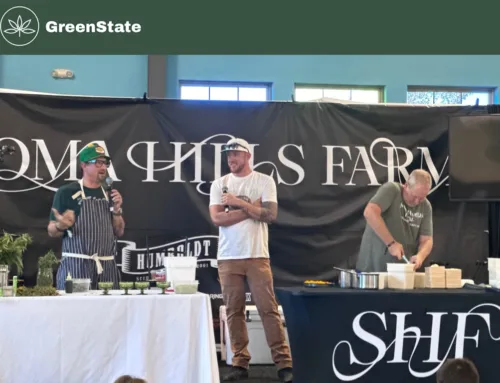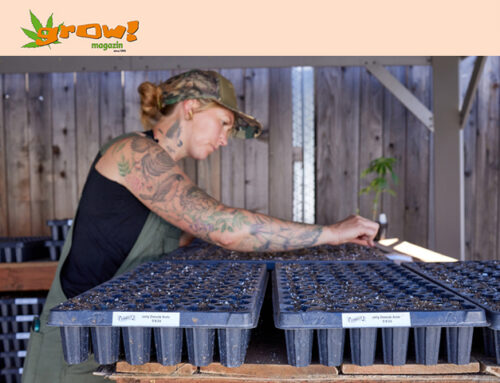Seed Companies Share 4 Grower Buying Trends
Seed Companies Share 4 Grower Buying Trends
Features – Seeds
Across the industry, many growers still make seed purchases solely based on THC percentage, and those growers want proof that cultivars perform well on potency.
1. Autoflowers are on the rise.
The three companies CBT spoke with for this story sell autoflowering cannabis cultivars that advance from their vegetative to flowering phases without a change in the amount of light that shines on them each day. Many are also faster-growing than non-autoflowering cultivars.
“Some [growers] are really appreciating the autoflower trait, and especially places that have seasonal restrictions and need to be able to time their harvest better or want to get multiple harvests,” says Nat Pennington, CEO of Humboldt Seed Company. Indoor growers are also purchasing autoflowering varieties, he adds.
Power says he has also recently seen more growers coming around to autoflowers. He adds that some greenhouse growers who grow autoflowers are yielding flowers that consistently test at more than 20% THC and are ready for harvest 55 days after sowing.
“The vestigial disdain of autoflowers is gone,” Power says.
The process of breeding quality autoflowers involves “de-linking” low potency from Cannabis ruderalis genetics, Power says, adding that Atlas Seed repeatedly back-crosses those genetics and repeats the process multiple times. “Great autos start with great photos,” Power says.
Landra D. is CEO of Vancoast Seeds, where top sellers have historically been classics such as White Widow, Green Crack, and Jack Herer, and now include Papaya Glue and Do-si-Dos. She says autoflower seeds work best if they contain at least 10% Cannabis ruderalis genetics, adding, “Autoflower seeds are best if you are working with a small growing space and low-maintenance plant.”
“Some [growers] are really appreciating the autoflower trait, and especially places that have seasonal restrictions and need to be able to time their harvest better or want to get multiple harvests.” – Nat Pennington, CEO, Humboldt Seed Company
2. Potency remains a benchmark.
Across the industry, many growers make seed purchases solely based on THC percentage, Power says, adding that growers want proof that cultivars perform well on potency.
“Every grower who is going to be spending some money with a genetics company wants to see certificates of analysis [COAs],” Power says. “But one thing that anybody in the cannabis industry with more than two seasons, or [even] one season, of experience, will tell you is that laboratory science is not as advanced as we’re all led to believe.”
Pennington shares that there is variability between potency results at various labs and that he believes some California testing labs are intentionally skewing results, reflecting Josh Wurzer of SC Labs’ claims to Leafly. “In California, lab shopping appears endemic,” according to the site, referring to growers’ decisions to test their cannabis at labs that offer higher THC results.
“When working with marijuana, no matter what part of the plant, high THC is considered a demand in the industry,” Landra D. says, adding that growers also seek out genetics that have short flowering times, specific terpenes, and high CBD levels.
Though THC is often the deciding factor for growers purchasing seeds, it’s Pennington’s belief that it shouldn’t be.
“Unfortunately, people are shopping for just that one number, so we’re breeding for that, for sure,” Pennington says.
He says he notifies his grower customers that growing practices influence potency.
“People can come in and say, ‘Give us seeds or clones that will test 30%,’” Pennington says. “But we’re always like, ‘Okay. You know, [for] these ones, we have COAs that people have gotten 30%, but a lot of it is just up to what you do while you’re growing.’”
Even in situations in which the THC test results are accurate, Pennington says he believes the chemical compositions of individual cultivars, aside from THC, can cause unique psychoactive effects to creep up on people.
“Someone might say, ‘I always smoke prerolls that are 25% [THC], and I’m fine to go to work an hour and a half later,’” he says. “And then they might smoke a different pre-roll that’s 25% and just be obliterated.”
“Every grower who is going to be spending some money with a genetics company wants to see certificates of analysis,” – Ryan Power, CEO, Atlas Seed
3. Agronomic qualities can dovetail with consumer appeal.
Between the time a cannabis seed is sown and the resulting plant’s flower or extracted material is consumed, cannabis cultivars express a vast variety of attributes. These include agronomic qualities, such as yield and resin production, and qualities that are of value to the consumer (as well as the cultivator), such as flavor and aroma.
Atlas Seed focuses its breeding on various agronomic considerations as well as what consumers gravitate toward, such as visually appealing crystals and a strong nose, Power says.
“What we’ve been doing is inbreeding selective parent lines who have demonstrated exceptional field traits–mold resistance, cannabinoid production, vigor, internodal spacing, [and] a low leaf-to-bud ratio or leaf mass index—which makes post-harvest a lot more efficient,” Power says. “We know, since we’re growers, that post-harvest is actually the biggest energetic and financial input on the cannabis farm. So, [we’re] breeding genetics basically for scaled production.”
Vancoast Seeds’ breeding focuses more on consumer appeal than agronomic factors, Landra D. says, while acknowledging that there’s a balance involved. Light schedules, curing processes, and feed schedules are all important, she says.
Humboldt Seed Company takes a similar approach. “We’ve definitely just really focused on what’s appealing to the consumer, … as long as the cannabis doesn’t do something that basically makes it so it’s not growable, like hermaphrodites, for example …,” he says. “It can be the ‘dankest flower in the world’ and no one wants to grow it or buy it because it’s full of seeds and it’s frustrating.”
Humboldt Seed Company has created inbred, which Pennington also refers to as “purebred,” lines; they take many generations of crosses and are then crossed to create F1 hybrids. Once Pennington and his colleagues’ genetics reach “heterosis,” or “hybrid vigor,” they address agronomic efficiencies, such as flowering time and disease resistance.
Some growers make purchasing decisions based on how cultivars with sensational consumer appeal perform in their field, greenhouse, or indoor grow, Pennington says, while other cultivators aren’t as concerned about the agronomic factors.
“There definitely are some varieties that have become incredibly popular, like the White Runtz, for example, that just makes these tiny, little flowers, and it’s hard to manage growing it,” Pennington says. “So, there are things that you can do to make it more agronomic and better for … a commercial grower or even just the backyard grower ….
“Some people might be like, ‘Well, I don’t care. I just want to grow really great stuff. And I don’t care if I don’t get a lot.’ But other people might be like, ‘I want to get a whole shit ton, and it’s got to last me the whole year’ or whatever,” he adds.
4. Cultivar considerations can be different when looking to extract and prerolls.
Some cannabis cultivars on the market work particularly well when used for extraction or inclusion in prerolls, Power says.
One trait that benefits the post-harvest process is low leaf volume, Power says. Businesses can save money in the processing step because there are fewer leaves to remove.
“The genetics that seem to have the lowest leaf volume [are] anything that’s in the Jack heritage; Jack Herer is really great for that,” Power says.
For their part, autoflowers often allow growers to conduct extraction more frequently than they would be able to with light-deprivation cultivars, Power says.
In hash-making processes, certain cultivars wash better, Power says, adding, “GMO is one of them. GMO is one of these lines that, for whatever reason, puts out a lot more hash, so, we’ve taken GMO and done a lot of work with her and have a GMO auto that we’re really excited about releasing this year.”
Landra D. says Hash Plant and Crown Royal are two cultivars from Vancoast Seeds that work well to produce concentrates because they produce large amounts of resin.
Power says “trimmability” is another trait that translates well to extraction and for use in prerolls.
“That’s the shape of the flower and the leaf mass so that [you can] just buck it and throw it in your machine trimmer,” Power says. “If [the flowers] are round or close to round, versus long, they’re going to machine-trim way better.”






